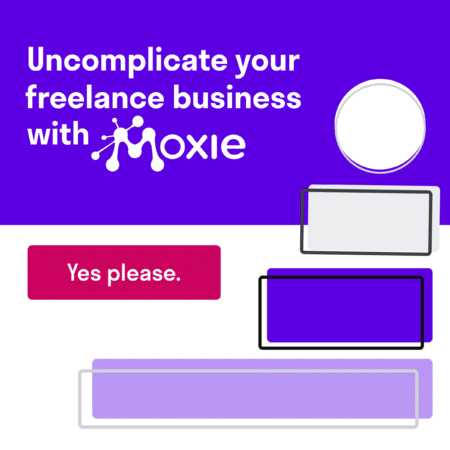Note: This article contains legal advice. We recommend you consult a lawyer before making legal decisions in your business.
Have you ever struggled to write a contract for ongoing work?
You’re not alone. One Millo reader commented:
Love the article you posted today about freelance with a contract. I’m curious, I can’t seem to find much out there for inspiration on writing a contract for revolving work. For instance I’m working with an agency that’s giving me production design one-off’s and giving me an hourly rate. I feel like I need to provide them with a contract but I don’t know what to put in because it seems atypical.
First off, I’m thrilled to read that you know you need a contract. (I guess all those “you need a contract!” posts are making a difference!)
You’re right – you do need a contract, and hopefully you never need to refer back to it. But it saves a TON of stress and headache later on if you do.
Also Read: A Jumpstart to Contracts for Creatives

How to write a KISS contract for ongoing work
Since this is a contract based on an hourly wage rather than a specific project, it’s best to Keep It Simple, Stupid. This is a cover-all-bases contract, so rather than nailing down the specifics of a project, you’re outlining your working relationship.
Here’s what to include (in a very loose order of importance):
#1 – Your hourly rate
(Obvious, I know.)
Also, if you’re going to give them a break after so many hours of work, include that here, too.
#2 – The pay schedule and terms
Whether it’s monthly, biweekly, or something else entirely, make sure you’re clear on when payment is due.
Pro Tip: Track your time for this client. Use accounting software or keep an Excel spreadsheet with these bare minimums:

- Date
- Length of time you worked
- Description of work done
Now, you may never need this, or your client may request it sent along with your invoice, but in the event they question what you spent 25 hours doing this month, your quick response with this information helps substantiate your claim.
#3 – The limit at which point you will not do further work until some or all of the bill is paid
(Sorry, if I had a shorter name for this I’d use that instead.)
Now, despite having specified a pay schedule, sometimes your client gets into you for a lot of money and you’re starting to get a teensy bit nervous that they owe you more than you’re comfortable adding to.
So it’s always in your best interest to establish a limit on further work until you get (at least partially) paid.
Example: It’s a busy month and you’ve hit your limit of $1500 of work 3 weeks in when another project hits. With this stipulation, you see some of your hard-earned cash before you start working on the next project.
True Story: I didn’t specify this and lost $1750 before I realized my client mishandled her finances and had no money to pay me.
#4 – The lines of communication
Always specify how you’ll contact one another, both by phone and email.
I know, this seems silly, but if they drop off the face of the earth mid-project, you want to be able to prove that you tried all means of agreed-upon communication repeatedly if you’re planning on taking your client to court.

#5 – Project usage rights
This one is almost always overlooked, but it’s huge.
Are you allowed to use the work in your portfolio? Are you allowed to claim the work as yours? Can you post works-in-progress on Behance or Dribbble?
Of course, you want these answers to be yes, but you don’t want to find out the hard way if that’s not the case.
Furthermore, you will immediately tarnish your credibility and professionalism and quite possibly lose your ongoing relationship due to such an oversight, especially if it’s their client who finds it first.
#6 – Contract length
Also often overlooked, and also huge.
So often we forget to specify how long the contract is good for, so it makes it INCREDIBLY difficult to raise our rates, change our payment terms, cap our hours, or decide we’re moving on to greener pastures.
If it’s a new client, maybe start with 90 days just to feel out the process. If you’re signing on to more frequent work for an established (hopefully awesome) client, you might choose 6 months or a year.
#7 – Miscellaneous information
I reserve this section for anything unusual or more specific about your relationship.

Things like:
- Minimum/maximum number of hours
- Project types you will/will not accept
- How to handle cost of goods sold (stock photography, font purchases, web hosting, etc.) and reimbursements
What goes in your ongoing work contracts?
Share your tips, trials, and success stories in the comments!
You can also download our ebook bundle all about contracts (which includes a collection of contract templates for creative folks) here.
Keep the conversation going...
Over 10,000 of us are having daily conversations over in our free Facebook group and we'd love to see you there. Join us!


Really good stuff, as if it was exclusively written for me… 😀
Awesome – thanks for letting me know!
April
Seriously, April. You nailed so many incredibly helpful tips
Awww…thanks, Stephanie! 🙂
For regular clients that pay on time and you have a good relationship no contract but below lets say 1k projects. Anything above that requires a contract. Also you can have them sign a contract valid for one year, make sure to state that any projects conducted from ___ date to ___ will fall under these terms.
Another thing is emails, for example to get an approval or finalization of a project, a confirmation in an email will do the job.
I usually note that will keep all files related to the job for 6 months. Usually, they are available in our studio archives for much longer, but sometimes older files become inaccessible for one reason or another.
Susan,
That’s a great addition to any contract – thanks for sharing!
April